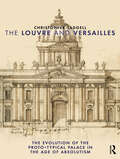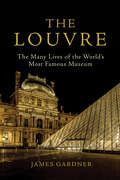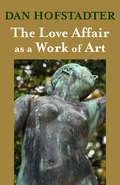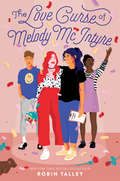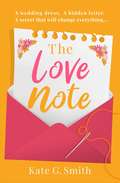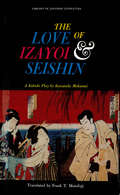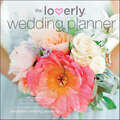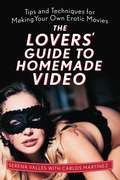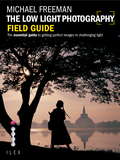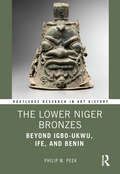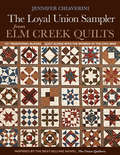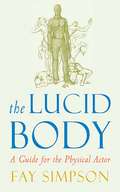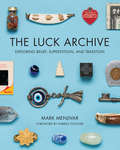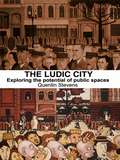- Table View
- List View
The Louvre and Versailles: The Evolution of the Proto-typical Palace in the Age of Absolutism
by Christopher TadgellIn tracing the evolution of the Louvre from fortress to palace and of Versailles from hunting domain to dynastic capital, Dr Tadgell’s detailed architectural analysis of many projects – external and internal, realised and unrealised – is set in the context of the development of the medieval monarchy towards absolutism, of the development of the medieval château towards precedents for the seat of absolutism, and of the effect of the French monarchy’s financial incontinence on the realisation of royal building ambitions.In particular, Tadgell challenges received opinion on the introduction of Hispano-Burgundian court etiquette to French palace design, relates the court front of Lescot’s Renaissance Louvre to the iconography of apotheosis, revises the current ordering of François Mansart’s designs for the Louvre and reassesses the subsequent contribution of Claude Perrault to the completion of the east front in respect for the opinion of 17th and 18th century commentators. After surveying the various phases of work for Louis XIV at Versailles, he traces the evolution of Ange-Jacques Gabriel’s grand projet for rebuilding the town side of the palace for Louis XV, noting the influence of Bernini on the definitive phase, and he masters the intricacies of the incessant changes to the royal apartments which inhibited rebuilding.Finally, the book looks at the influence of the great French palaces on those seeking to emulate their ambition, from Stockholm in the late-17th century to the deliriously opulent late-19th century palace of Ludwig II of Bavaria at Herrenchiemsee. A wealth of illustrative material and supporting documents bring this comprehensive and authoritative text to life.
The Louvre: The Many Lives of the World's Most Famous Museum
by James GardnerThe centuries-long history of the Louvre, from humble fortress to Royal palace to the world’s greatest art museum—with photos and building maps.Some ten million people from all over the world flock to the Louvre each year to enjoy its incomparable art collection. Yet few of them are aware of the remarkable history of the site and buildings themselves—a fascinating story that historian James Gardner elegantly chronicles in this authoritative history.More than seven thousand years ago, men and women camped on a spot called le Louvre for reasons unknown. Centuries later, King Philippe Auguste of France constructed a fortress there, just outside the walls of a nascent Paris. Intended to protect the capital against English soldiers stationed in Normandy, the fortress became a royal residence under Charles V two centuries later, and then the monarchy’s principal residence under the great Renaissance king François I.In 1682, when Louis XIV moved his court to Versailles, the Louvre languished until the French Revolution when, during the Reign of Terror in 1793, it first opened its doors to display the nation’s treasures. Ever since—through the Napoleonic era, the Commune, two World Wars, to the present—the Louvre has been a witness to French history, and expanded to become home to a legendary art collection that includes the Mona Lisa and Venus de Milo.Includes sixteen pages of full-color photos illustrating the history of the Louvre, a full-color map detailing its evolution from fortress to museum, and black-and-white images throughout the narrative.
The Love Affair as a Work of Art
by Dan HofstadterThis series of entwined biographical sketches recounts how, in the Romantic Era, love affairs, often illicit, were transformed into novels, memoirs, and published correspondences. We make the intimate acquaintance of great writers like Mme de Staël, Chateaubriand, George Sand, and Anatole France, who, however, fall gradually under the suspicion of pursuing their amorous entanglements for "good material." The tale ends with a moving account, based on unpublished sources, of the strange, intense friendship of Marcel Proust and Jeanne Pouquet, the girl who became the model for Gilberte in Swann's Way. Disenchanted yet compassionate, this book explores how our affections may be exalted (and at times betrayed) by our desire to refashion them as stories.
The Love Curse of Melody McIntyre
by Robin TalleyPerfect for fans of Becky Albertalli and Nina LaCour, this #ownvoices romantic comedy from New York Times bestselling author Robin Talley has something for everyone: backstage rendezvous, deadly props, and a seemingly insurmountable obstacle to True Love.Melody McIntyre, stage manager extraordinaire, has a plan for everything. What she doesn’t have? Success with love. Every time she falls for someone during a school performance, both the romance and the show end in catastrophe. So, Mel swears off any entanglements until their upcoming production of Les Mis is over. Of course, Mel didn’t count on Odile Rose, rising star in the acting world, auditioning for the spring performance. And she definitely didn’t expect Odile to be sweet and funny, and care as much about the play’s success as Mel. Which means that Melody McIntyre’s only plan now is trying desperately not to fall in love.
The Love Note: A heartwarming and uplifting page-turner
by Kate G. Smith'Life-affirming, emotional and fun! A fabulous roller coaster of a read. I loved it!' Heidi SwainA wedding dress. A love letter. A secret that will change everything...When Maggie Burnett discovers her mother's beautiful wedding dress just days after she passes away, she wonders why she'd been told it was missing... Pinned to the waistband is a note that reads: 'E, je t'aime. LS x' . 'E' must be Elizabeth, her mother, but who is 'LS'? Could he be the father she's never known? As Maggie's seemingly happy life in London unravels, she decides it's time to go home to Norfolk and figure out the truth once and for all. Even if it means running into Nick Forster, her secret childhood crush. What if this journey to the past is the key to a new beginning?Warm and uplifting, The Love Note is perfect for fans of Lia Louis and Olivia Beirne. See what readers are saying:'Sweet, special and very relatable with the various events that occur throughout this book. This has all the best ingredients for a perfect romance novel. Loved it''I absolutely adored this book! Stunning, a page-turner which stays long in the memory!''Perfect for a sunny day beach read''This story moves quickly and is an easy read. I really enjoyed it''The character development was fantastic and the between the two main characters was amazing. I could not put this book down.. I cannot wait for the next book!'
The Love Note: A heartwarming and uplifting page-turner
by Kate G. Smith'Life-affirming, emotional and fun! A fabulous roller coaster of a read. I loved it!' Heidi Swain'A fabulous, fun and flirty summer read!' Jenni KeerA wedding dress. A love letter. A secret that will change everything...When Maggie Burnett discovers her mother's beautiful wedding dress just days after she passes away, she wonders why she'd been told it was missing... Pinned to the waistband is a note that reads: 'E, je t'aime. LS x' . 'E' must be Elizabeth, her mother, but who is 'LS'? Could he be the father she's never known? As Maggie's seemingly happy life in London unravels, she decides it's time to go home to Norfolk and figure out the truth once and for all. Even if it means running into Nick Forster, her secret childhood crush. What if this journey to the past is the key to a new beginning?Warm and uplifting, The Love Note is perfect for fans of Lia Louis and Olivia Beirne. See what readers are saying:'Sweet, special and very relatable with the various events that occur throughout this book. This has all the best ingredients for a perfect romance novel. Loved it''I absolutely adored this book! Stunning, a page-turner which stays long in the memory!''Perfect for a sunny day beach read''This story moves quickly and is an easy read. I really enjoyed it''The character development was fantastic and the between the two main characters was amazing. I could not put this book down.. I cannot wait for the next book!'
The Love of Izayoi & Seishin: A Kabuki Play by Kawatake Mokuami
by Kawatake Mokuami Frank T. MotofujiThis dramatic and absorbing play tells the story of the courtesan Izayoi and the priest Seishin; classic lovers who are doomed to suffer the tragic consequences of their passion.<P><P>As a representative example of Japanese play writing of the 19th century The Love of Izayoi and Seishin is a superlative example of the turbulence and dramatic incident that are the major conventions of Kabuki.The intricate plot involves murder, attempted suicide, hari-kiri, theft, and the usual stunning Kabuki denouement. This specific feature is one of the intriguing aspects of Kabuki drama, and continually keeps the stage alive with action and violence.Complete with stage directions and complementary instructions, this play can be read with pleasure for its own sake, or as a gripping Kabuki narrative for all enthusiasts of the theater.
The Loverly Wedding Planner: The Modern Couple's Guide to Simplified Wedding Planning
by Kellee KhalilYour Modern Guide for Planning a Wedding that's Perfectly YouPlanning a wedding can be a bit overwhelming, but with the helpful how-tos and insider advice in this handy guide, you can forget the stress and focus on creating a day that truly reflects you as a couple. The Loverly Wedding Planner has everything you need to navigate the planning process in a way that is simple, meaningful, and really enjoyable.Kellee and Loverly's team of experts will help you plan a memorable, and perfectly personalized wedding, with:- Updated advice for fast-evolving wedding customs like mixed-gender bridal parties, social media etiquette, unplugged weddings, same-sex ceremonies, and more- Wedding worksheets and timelines that will help you stay organized and on track with detailed schedules, budgets, and to-do lists- Down and dirty checklists to help you prioritize and streamline every step of the planning process - Insider tips from Kellee, the Loverly team, and real-life couples who have recently said "I do"- Budget breakdowns from modern couples with differing allowances and priorities, as well as a handy section on contracts and negotiation
The Lovers' Guide to Homemade Video: Tips and Techniques for Making Your Own Erotic Movies
by Carlos Martínez Serena VallésInside every person, as timid as they might seem, dwells a being who feels curious about or enjoys watching themselves naked in erotic situations, whether it's alone or with a partner. This manual provides the tools to enjoy this exciting game with skill and creativity.At the time of shooting an erotic film, there can be some uncertainties: Which are the best angles? What type of lighting best expresses the sensuality? How can the most beautiful body parts be highlighted? Is it necessary to prepare a script? What kind of limits do you create?The Lovers' Guide to Homemade Video is a pioneering guide to discovering new and exciting erotic possibilities: from filming a striptease, to a movie more subdued in tone, to a stimulating session of nude photography.The abundantly illustrated pages include, amongst other topics: The most suggestive erotic ideas and guides The art of the striptease The most exciting plans, scenes, and sequences Lighting, sets, and accessories Editing and digital effects All kinds of tricks to make the most out of the camera
The Low Light Photography Field Guide: Go Beyond Daylight To Capture Stunning Low Light Images (Field Guide Ser.)
by Michael FreemanMichael Freeman looks at an area that remains problematic for photographers with even top-of-the-range equipment - low light. Opening with a section on the qualities of different kinds of low light, the text then deals with ways of overcoming gloomy situations, whether you're shooting hand-held or on a tripod.
The Low Light Photography Field Guide: Go Beyond Daylight To Capture Stunning Low Light Images (Field Guide Ser.)
by Michael FreemanLike all the titles in this successful series, The Low Light Photography Field Guide offers advice from a respected expert and professional. In this volume, Michael Freeman looks at an area that remains problematic for photographers with even top-of-the range equipment: low light.Opening with a section on the qualities of different kinds of low light, the book then deals with ways of overcoming gloomy situations, whether you're shooting hand-held or on a tripod. Post-production fixes are also covered, allowing the reader to turn difficult shots into amazing images.
The Lower Niger Bronzes: Beyond Igbo-Ukwu, Ife, and Benin (Routledge Research in Art History)
by Philip M. PeekThis book demonstrates that copper-alloy casting was widespread in southern Nigeria and has been practiced for at least a millennium. Philip M. Peek’s research provides a critical context for the better-known casting traditions of Igbo-Ukwu, Ife, and Benin. Both the necessary ores and casting skills were widely available, contrary to previous scholarly assumptions. The majority of the Lower Niger Bronzes, which we know number in the thousands, are of subjects not found elsewhere, such as leopard skull replicas, grotesque bell heads, ritual objects, and humanoid figures. Important puzzle pieces are now in place to permit a more complete reconstruction of southern Nigerian history. The book will be of interest to scholars working in art history, African studies, African history, and anthropology.
The Lower Niger Bronzes: Beyond Igbo-Ukwu, Ife, and Benin (Routledge Research in Art History)
by Philip M. PeekThis book demonstrates that copper-alloy casting was widespread in southern Nigeria and has been practiced for at least a millennium. Philip M. Peek’s research provides a critical context for the better-known casting traditions of Igbo-Ukwu, Ife, and Benin. Both the necessary ores and casting skills were widely available, contrary to previous scholarly assumptions. The majority of the Lower Niger Bronzes, which we know number in the thousands, are of subjects not found elsewhere, such as leopard skull replicas, grotesque bell heads, ritual objects, and humanoid figures. Important puzzle pieces are now in place to permit a more complete reconstruction of southern Nigerian history. The book will be of interest to scholars working in art history, African studies, African history, and anthropology.
The Loyal Union Sampler from Elm Creek Quilts: 121 Traditional Blocks * Quilt Along With The Women Of The Civil War
by Jennifer ChiaveriniStitch a piece of history with patterns for making your own quilt inspired by the New York Times–bestselling series! Inspired by Jennifer Chiaverini&’s bestselling novel The Union Quilters, this sampler quilt offers a treasure trove of traditional blocks sewn by the women of Elm Creek Valley to support their troops during the American Civil War. The book includes historical notes on the novel and photos of nine Loyal Union Samplers made by Jennifer and other Elm Creek Quilts lovers from around the world. These blocks can be mixed and matched with blocks from Jennifer&’s wildly popular Elm Creek Quilts sampler, Sylvia's Bridal Sampler. ·121 traditional 6&” quilt blocks ·Links to full-sized patterns for every block, plus instructions for assembling the quilt ·Start an Elm Creek Quilt club and feature a different block at each meeting
The Lucid Body: A Guide for the Physical Actor
by Fay SimpsonNovice actors and stage veterans alike will discover a deeper level of consciousness through the exercises outlined in The Lucid Body: A Guide for the Physical Actor. Developed by Fay Simpson, an Actors Center member and co-founder of Impact Theatre, The Lucid Body is a cutting-edge technique that lets you combine eastern yoga elements with your contemporary western way of life to bring truth to your acting and inner clarity to your life. The Lucid Body technique has been presented by the author for 15 years in workshops, rehearsals, and schools, teaching actors to access their seven chakra centers. Now you can practice in your own home what hundreds of others have already discovered at the Yale School of Drama, NYU, and the Michael Howard Studios. Add vital energy to your life and your acting with The Lucid Body.
The Lucid Body: A Guide for the Physical Actor
by Fay Simpson&“From Fay&’s methodology, I learned to use my intuition and lived experiences in myriad new ways.&” —Winston Duke, actor, Black Panther, Avengers, Us, and Nine DaysEngaging Mind and Body to Develop the Complete Physical Nature of Characters Actors are shape-shifters, requiring the tools to wade into unfamiliar waters and back out again. The Lucid Body offers a holistic, somatic approach to embodying character from the inside-out and, for the non-actor, offers a way to give hidden parts of the self their full expression. By identifying stagnant movement patterns, this process expands one&’s emotional and physical range and enables the creation of characters from all walks of life—however cruel, desolate, or jolly. Rooted in the exploration of the seven chakra energy centers, The Lucid Body reveals how each body holds the possibility of every human condition. Readers will learn how to: Practice a non-judgmental approach to the journey of self-awarenessBreak up stagnant and restrictive patterns of thought and movementAllow an audible exhale to be the key to unlocking the breathDevelop a mindset to &“hear&” one&’s inner bodyAnalyze the human condition through the psycho-physical lens of the chakrasExperience the safety of coming back to a neutral bodyAcquire a sense of clarity and calm in one&’s everyday life A step-by-step program guides the actor through the phases of self-awareness that expand emotional and physical range not only on stage, but also in daily life. This new edition includes a more diversified range of playwrights, non-binary language, and new chapters on stage intimacy protocol and physical listening. Exercises that have been honed for the past ten years have been made more concise. New somatic and neuro-scientific data has been added, with additional wisdom and insights from colleagues and Simpson's team of Lucid Body teachers.
The Luck Archive
by Harrell Fletcher Mark MenjivarArtist Mark Menjivar was in an antique bookshop in Fort Wayne, Indiana, when he found 4 four-leaf clovers pressed between the yellowed pages of an aged copy of 1000 Facts Worth Knowing. Their discovery beguiled Menjivar so much that he began a multiyear exploration into the concept of luck and its intersections with belief, culture, superstition, and tradition in people's lives.Menjivar has spent hours and days engaging people in airplanes, tattoo shops, bingo halls, international grocery stores, public parks, baseball stadiums, and voodoo shops-and out on the streets and in their homes. Along the way he documented his findings to create a physical archive that contains hundreds of objects (rings, underwear, food items, clovers, horses, pigs, herbs, rainbows, lottery strategies, seeds, day trader insights, statues, patches, crystals, spices) and the stories and pictures that go with them.Through photographs and first person accounts, The Luck Archive takes the best of these ideas, thoughts, and objects and gives readers a glimpse into the cultures and superstitions of a colorful array of humanity.
The Lucky Greyhound
by Beverly Helmbold Erschell Viktoria Grimme Barbara Sweet[From the back cover:] "The Lucky Greyhound is the inspirational story of Maple, a bred-to-race greyhound who wasn't cut out for the track. Luckily, Maple is adopted, first by a veterinarian and then by an artist and medical technician. Maple is a truly extraordinary dog that leaves the racetrack behind to live in a dramatically different world. Her adaptable nature and loving adoptive parents provide Maple with the tools for success in her new life. The story reverberates with her triumph. Written and Illustrated by Beverly Hembold Erschell, a renowned artist living in Greater Cincinnati, The Lucky Greyhound features more than thirty of Erschell's original artworks. They were created expressly for this highly collectible book." Pictures are described with explanations of the artist's varying styles. Dog loving readers of any age will enjoy this short book full of facts about greyhounds and descriptions of loving experiences with Maple, an exuberant, loyal rescued pet.
The Ludic City: Exploring the Potential of Public Spaces
by Quentin StevensThis international and illustrated work challenges current writings focussing on the problems of urban public space to present a more nuanced and dialectical conception of urban life. Detailed and extensive international urban case studies show how urban open spaces are used for play, which is defined and discussed using Caillois' four-part definition – competition, chance, simulation and vertigo. Stevens explores and analyzes these case studies according to locations where play has been observed: paths, intersections, thresholds, boundaries and props. Applicable to a wide-range of countries and city forms, The Ludic City is a fascinating and stimulating read for all who are involved or interested in the design of urban spaces.
The Luftwaffe Battle of Britain Fighter Pilot's Kitbag: Uniforms & Equipment from the Summer of 1940 and the Human Stories Behind Them
by Mark Hillier&“Detail[s] German fighter pilots&’ flying helmets, oxygen masks, goggles . . . and other ephemera . . . brilliantly done—and completely engrossing.&”—The Aviation Historian Reichsmarschall Gring told Hitler that it would take less than a month for his much-vaunted Luftwaffe to conquer the RAF and pave the way for the German invasion of Great Britain. His prediction was to prove disastrously wrong, but for four long months his pilots and aircrew fought for their lives in the skies above the UK. From their bases in continental Europe, the Luftwaffe&’s fighter pilots escorted the great bomber fleets that sought to destroy the RAF&’s airfields and installations, and tackled the Spitfires and Hurricanes deployed to defend Britain&’s towns and cities. Whilst much has been written on the titanic struggle for supremacy fought throughout the summer of 1940 and of the men and machines of both sides, little attention has been paid to what the pilots wore and carried with them in the air. All the objects that a Luftwaffe fighter pilot was issued with during the Battle of Britain are explored in this book in high-definition color photographs, showing everything from the differing uniforms, to headgear, personal weapons, gloves, goggles, parachute packs and the essential life jacket. Each item is fully described and its purpose and use explained. Fly with the Messerschmitt Bf 109s and Bf 110s across the Channel and see what the Luftwaffe aircrew wore as they took on Fighter Command in what was justly called the Battle of Britain. &“An outstanding example of history through artifacts.&”—Schopenhauer's Workshop
The Luminous Portrait: Capture the Beauty of Natural Light for Glowing, Flattering Photographs
by Jacqueline Tobin Ulrica Wihlborg Elizabeth MessinaInfuse your images with glowing, luminous light, From high-profile wedding and portrait photographer Elizabeth Messina comes this beautiful guide to shooting lush, romantic portraits exclusively in natural light. Whether you're photographing children, weddings, maternity and boudoir, or portraits of any kind, The Luminous Portrait will inspire you with Elizabeth's personal approach and award-wining images, sharing the art to making flattering portraits that appear "lit from within."
The Lumière Galaxy
by Francesco CasettiFrancesco Casetti believes new media technologies are producing an exciting new era in cinema aesthetics. Whether we experience film in the theater, on our hand-held devices, in galleries and museums, onboard and in flight, or up in the clouds in the bits we download, cinema continues to alter our habits and excite our imaginations.Casetti travels from the remote corners of film history and theory to the most surprising sites on the internet and in our cities to prove the ongoing relevance of cinema. He does away with traditional notions of canon, repetition, apparatus, and spectatorship in favor of new keywords, including expansion, relocation, assemblage, and performance. The result is an innovative understanding of cinema's place in our lives and culture, along with a critical sea-change in the study of the art. The more the nature of cinema transforms, the more it discovers its own identity, and Casetti helps readers realize the galaxy of possibilities embedded in the medium.
The Lumière Galaxy: Seven Key Words for the Cinema to Come (Film and Culture Series)
by Francesco CasettiFrancesco Casetti believes new media technologies are producing an exciting new era in cinema aesthetics. Whether we experience film in the theater, on our hand-held devices, in galleries and museums, onboard and in flight, or up in the clouds in the bits we download, cinema continues to alter our habits and excite our imaginations. Casetti travels from the remote corners of film history and theory to the most surprising sites on the internet and in our cities to prove the ongoing relevance of cinema. He does away with traditional notions of canon, repetition, apparatus, and spectatorship in favor of new keywords, including expansion, relocation, assemblage, and performance. The result is an innovative understanding of cinema's place in our lives and culture, along with a critical sea-change in the study of the art. The more the nature of cinema transforms, the more it discovers its own identity, and Casetti helps readers realize the galaxy of possibilities embedded in the medium.
The Lure of Perfection: Fashion and Ballet, 1780-1830
by Judith BennahumTHE LURE OF PERFECTION: FASHION AND BALLET, 1780-1830 offers a unique look at how ballet influenced contemporary fashion and women's body image, and how street fashions in turn were reflected by the costumes worn by ballet dancers. Through years of research, the author has traced the interplay between fashion, social trends, and the development of dance. During the 18th century, women literally took up twice as much space as men; their billowing dresses ballooned out from their figures, sometimes a full 55 inches, to display costly jewelry and fine brocade work; similar costumes appeared on stage. But clothing also limited her movement; it literally disabled them, making the dances themselves little more than tableaux. Movement was further inhibited by high shoes and tight corsets; thus the image of the rigidly straight, long-lined dancer is as much a product of clothing as aesthetics. However, with changing times came new trends. An increased interest in natural movement and the common folk led to less-restrictive clothing. As viewers demanded more virtuosic dancers, women literally danced their way to freedom. THE LURE OF PERFECTION will interest students of dance and cultural history, and women's studies. It is a fascinating, well-researched look at the interplay of fashion, dance, and culture-still very much a part of our world today.
